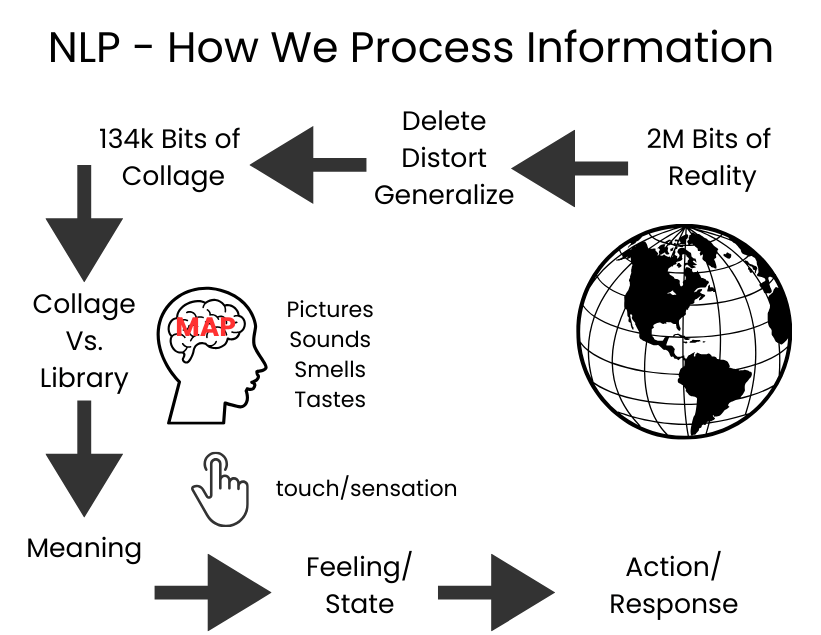You might remember me mentioning Neuro Linguistic Programming (NLP) in my previous blog post. Well, I wasn’t just dropping buzzwords—I’m actually knee-deep in NLP sessions still right now! As I explained there, it’s all part of my quest to reprogram some deeply ingrained patterns that have been making life a bit bumpy, especially when it comes to my health.
I’m talking about those sneaky, subconscious patterns that we all have, the ones that can sabotage our best efforts without us even realizing it. My goal is to deconstruct and/or rewrite these patterns at their core, to create lasting positive change from the inside out.
I’ll admit, I jumped into these NLP sessions with more enthusiasm than knowledge. I had a vague idea of what it was about, but as we progressed, I realized just how much I didn’t know! So, I decided to turn my curiosity into a learning opportunity—for both of us! Consider this blog post a deep dive into the world of NLP, exploring its mechanisms, applications, and potential for transformation.
What Exactly is NLP?
Imagine this: You’re holding a map. But here’s the catch—it’s not a map of the physical world, but a map of your own unique perception of reality. That’s essentially what NLP is all about—understanding how we create our internal maps and how we can redraw them to achieve the life we desire.

NLP was developed back in the 1970s by Richard Bandler and John Grinder. They were fascinated by the idea that excellence leaves clues. So, they studied the patterns of thought and behavior in fields like therapy, business, and communication to understand what made people successful. Their groundbreaking work, documented in books like “The Structure of Magic” and “Frogs into Princes,” laid the foundation for this powerful field.
From their research, they developed a set of tools and techniques that allow us to:
- Model Excellence: Ever wonder how some people seem to effortlessly excel in their fields? NLP provides a framework to study their strategies and replicate their success.
- Manage Our Internal State: We all experience those moments of stress, anxiety, or self-doubt. NLP equips us with techniques to regulate our emotions and reactions, empowering us to stay calm and resourceful in challenging situations.
- Accelerate Learning: Want to learn a new skill faster? NLP helps us identify and adopt the learning strategies of experts, making the process more efficient and enjoyable.

The NLP Map: Deciphering Our Subjective Reality
Remember that map analogy? Let’s dive a bit deeper into how NLP views our experience of reality:
- The Territory (Reality): The world around us is bombarding us with information constantly—sights, sounds, smells, sensations. It’s estimated that we receive around 2 million bits of information per second!
- Filters: Our brains can’t possibly process all that information, so we filter it based on our beliefs, values, past experiences, and even our current emotional state. This filtering process reduces the information to a more manageable 134,000 bits per second.
- Internal Representation: The filtered information is then used to create our internal representation of reality—our own personal map. We use our senses (visual, auditory, kinesthetic) to construct this internal world.
- Comparison: We constantly compare our internal map to our memories and past experiences, searching for a match.
- Meaning: When we find a match, we assign meaning to the experience. This meaning shapes our emotions, thoughts, and ultimately, our behaviors.

Here’s the key takeaway: We don’t respond to reality itself, but to our own subjective map of it. This means that two people can experience the same event in completely different ways based on their unique filters and interpretations.
Dr. Richard Bandler: Insights from the Co-Creator Himself
In an interview, Dr. Richard Bandler, one of the brilliant minds behind NLP, shared some profound insights:
"If you don't have a choice, you can't make one." Dr. Bandler emphasizes the incredible human capacity for change. He believes that even deeply ingrained behaviors can be transformed by understanding how they were learned in the first place.
"It's not about stopping your internal dialogue, it's about using it when you should." We all have that inner voice, but sometimes it can spiral into negativity. Dr. Bandler suggests techniques to control our internal dialogue, like adjusting its speed, volume, or even tone, to manage our thoughts and emotions more effectively.
"There is no mind-body split. If you ain't got one, you ain't got the other." Dr. Bandler highlights the interconnectedness of our minds and bodies. Our thoughts and emotions have a direct impact on our physical well-being, and vice versa.
A Glimpse into the NLP Toolkit: Powerful Techniques for Transformation
One of the things I find most fascinating about NLP is its diverse toolkit of techniques. Here are a few examples:
- Anchoring: Linking a specific emotion or state of mind to a particular stimulus, like a touch, word, or image. This allows us to access that desired state more easily in the future.
- Visual/Auditory/Kinesthetic (VAK) Model: Understanding how people perceive and process information through different sensory systems (sight, sound, feeling). This knowledge helps tailor communication for better understanding and connection.
- Reframing: Shifting our perspective on a situation to view it in a more positive or empowering light. This can be incredibly helpful in overcoming limiting beliefs and managing challenging emotions.
- Swish Pattern: A technique for replacing unwanted behaviors or thoughts with more desirable ones by creating a rapid “swish” between the two in our minds.
- Submodalities: Exploring the finer distinctions within each sensory system (e.g., brightness, size, color of an image) and consciously changing them to alter the intensity of our feelings and responses.
- Rapport Building: Utilizing techniques like mirroring and matching body language, voice tone, and breathing patterns to create unconscious connection and trust with others.
My Ongoing NLP Journey: Embracing the Power of Transformation
One thing that’s been on my mind lately is the connection between NLP and hypnosis. They seem to dance in a similar realm of the subconscious, but the line between them feels blurry. I haven’t found any resources that fully satisfy my curiosity about their similarities and differences. It’s definitely something I’m going to explore further, and I promise to share my findings in a future blog post!
This journey with NLP has been eye-opening, to say the least. It’s shown me the incredible power we have to shape our own realities and create the lives we desire.
What about you? Have you had any experience with NLP or other techniques that tap into the power of the subconscious mind? I’d love to hear your thoughts and experiences in the comments below!

